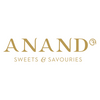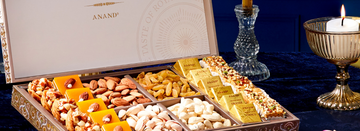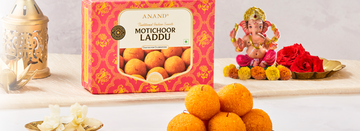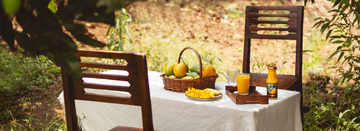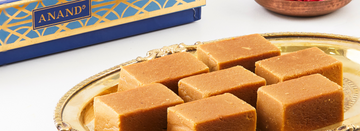From Ludhiana to London, the chicken tikka and butter masala happily brush shoulders with Western steaks and bakes. But these are not the lone Indian favourites across the world. Indian sweets, our delicious meethais, too equally delight global palates with their myriad nuances that find interesting echoes in Western sweets and desserts.
Let’s take a look at where the ‘twain’ - East and West - do indeed meet, and why Indian sweets are able to serenade global tastes. And, so sweetly.
Twinning Textures

Textures of Indian sweets often have surprising parallels among Western favourites. The chewiness of toffee candy, for instance, finds a sweet echo in the rich Karachi halwa. The sweet traces its origins to Persia - clearly, a globetrotter by itself!
The Anand Sweets Dry Fruit Halwa, redolent with the scent of cow ghee or clarified butter, is packed with a delicious medley of nuts. Chewy and crunchy all at once, the Anand Sweets Dry Fruit Halwa leaves a lingering taste of sweetness. Perfectly packaged to be parcelled out, it has a shelf life of several months.
The fibrous, crumbly nature of soan papdi is like a baked fruit crumble. The Anand Sweets Soan Papdi is delicious - and healthy too. It’s made of clarified butter or ghee, and fibre-rich gram flour which is full of protein. Our Soan Papdi travels well and stays fresh for as long as six months. A favourite across several countries, the soan papdi may be served as an interesting dessert to end a Western meal, or as an accompaniment to afternoon tea – sometimes replacing the tea cake.
Then, there are old-favourites such as the peda that bears a marked similarity with the age-old Western tradition of fudgy sweets, and finds instant favour with global tastes.
Coming Together at the Base

The base of Indian sweets and Western desserts too tend to be similar. Most Western desserts have a dairy base of milk, butter and cream (who can resist the delicious aroma of a freshly baked butter cake!). In several Indian meethais, a healthier version of butter – ghee or clarified butter – is the lead ingredient.
Ghee is made separating milk from fat making it lactose-free. It’s rich in Vitamin A and Omega 3 – both good nutrients for immunity and heart health. Sweet, fragrant, delicious, and healthy too – the ghee-based Indian sweetmeat is the perfect end to any meal, Indian or Western, elaborate or simple.
The smoky, rich aroma of ghee is the hallmark of a host of rich Indian meethais at Anand Sweets. These include burfis and laddoos, as well as the famous export of Karnataka – the Mysore Pak, first created in the royal kitchens of Mysore in 1935, and now enjoyed all over the world.
All these ghee-based sweets have a long shelf life (ghee does not spoil even when not refrigerated) and are a favourite with overseas patrons.
The charming tradition of laddus being a celebratory treat, further add to their appeal. In the recent serial New Amsterdam, the Indian doctor played by Anupam Kher is shown carrying dabba of laddus to the hospital to celebrate happy occasions – his American colleagues all love the sweets.
Universal appeal of nuts

From pecan pies to pralines, nuts are at the centre of several Western desserts. The world does indeed go nuts over nuts! Indian meethais too have been using nuts as an ingredient down the ages. Fresh cashew, almond, walnuts and more are used in a host of Indian sweets making them crunchy and pushing up the nutrient value.
In sweets such as the kaju katli, nuts are not just used as garnish or an added ingredient, but comprise the core of the sweet. Protein-rich, the scrumptious kaju katli gives an instant energy boost. The silver-foil covered Anand Sweets Kaju Katli uses premium quality cashew and has a melt-in-mouth consistency. Totally addictive!
Infusions add the Special Touch
 Much like Western desserts, a lot of Indian sweets too are infused with interesting flavours. Like chocolate desserts in the West may be infused with orange and vanilla flavours, Indian meethais too are particularly prized for the delicacy of natural infusions: the sweet scent of cardamom, the heady notes of rose, the rich essence of saffron add to the allure.
Much like Western desserts, a lot of Indian sweets too are infused with interesting flavours. Like chocolate desserts in the West may be infused with orange and vanilla flavours, Indian meethais too are particularly prized for the delicacy of natural infusions: the sweet scent of cardamom, the heady notes of rose, the rich essence of saffron add to the allure.
The Anand Sweets Dry Fruits Halwa, for instance, comes infused with the scent of saffron, while the special Gulkand Kaju Katli and Strawberry Kaju Katli are infused with the heady scents of rose and citrusy strawberry.
Anand: Reaching out to World with Indian sweets
Whether it be a matter of similar texture or use of familiar base ingredients, Indian sweets resonate perfectly with Western palates. Did you know that that Anand exports its products to US, Canada, Australia, Singapore, Qatar, Papua New Guinea and Doha?
Indeed, the proof of the pudding is in the eating – so at Anand Sweets we continuously reach out to all lovers of sweets across the world to invite them to experience and revel in the sweet world of the Indian meethai.
